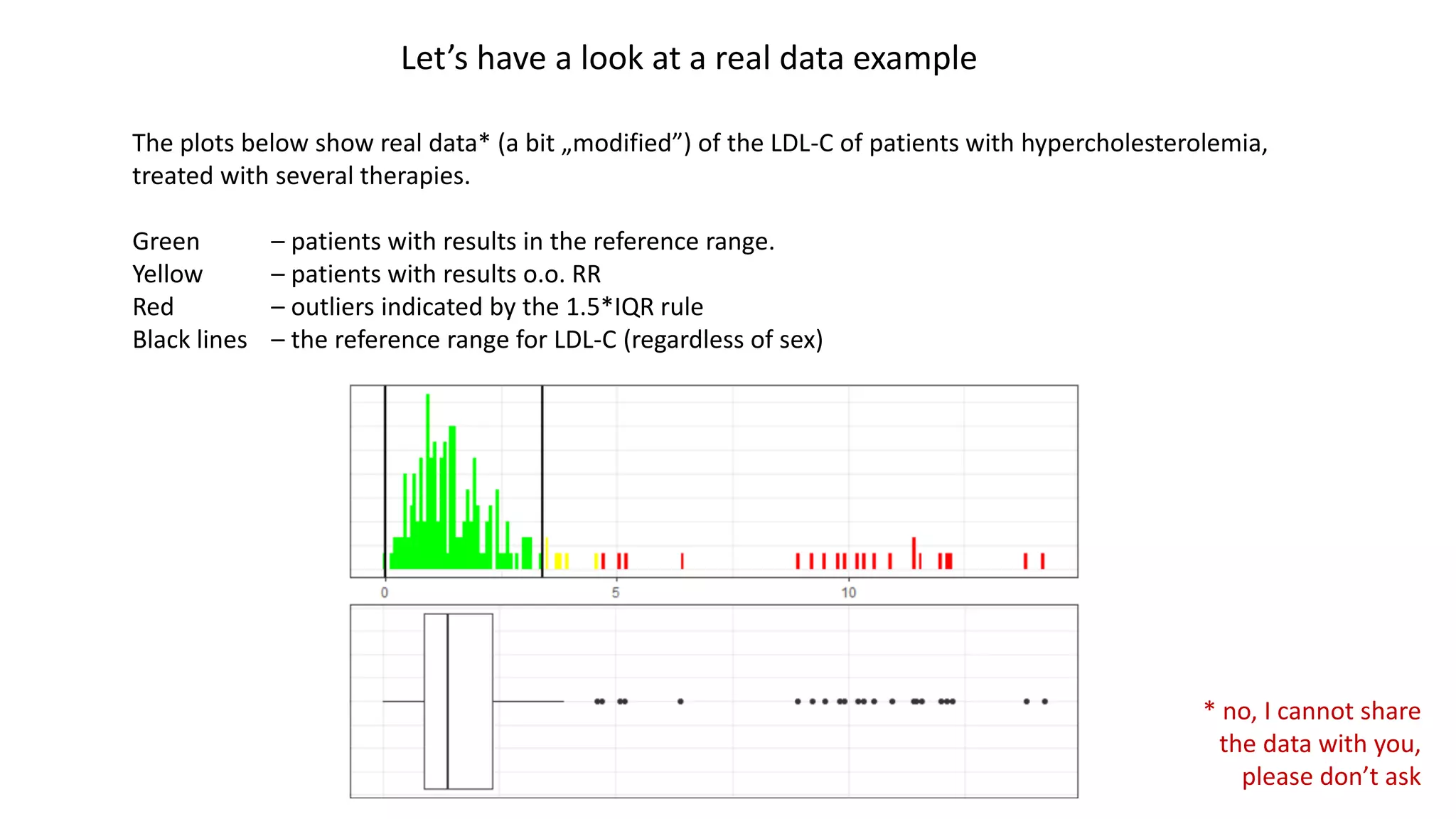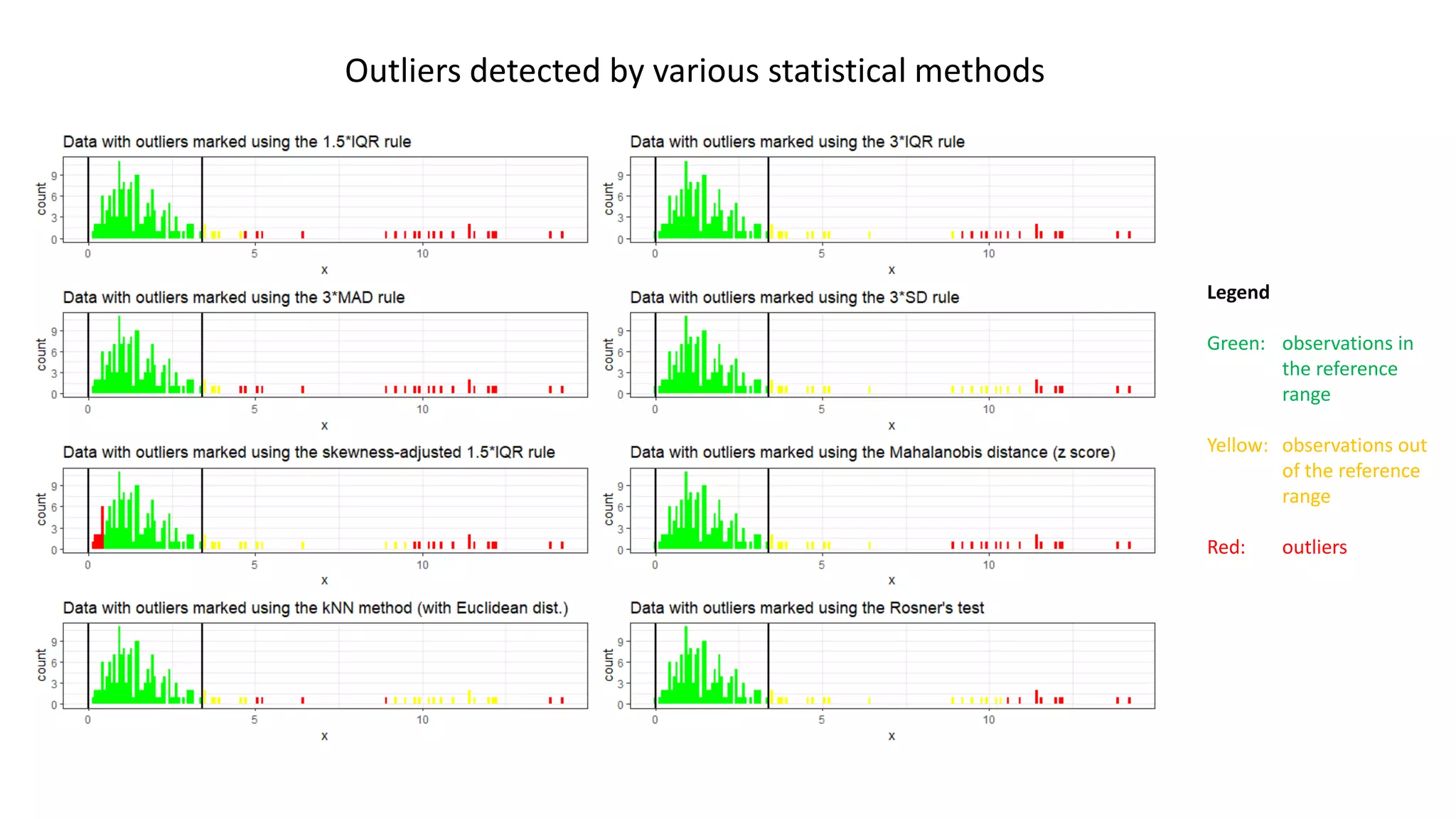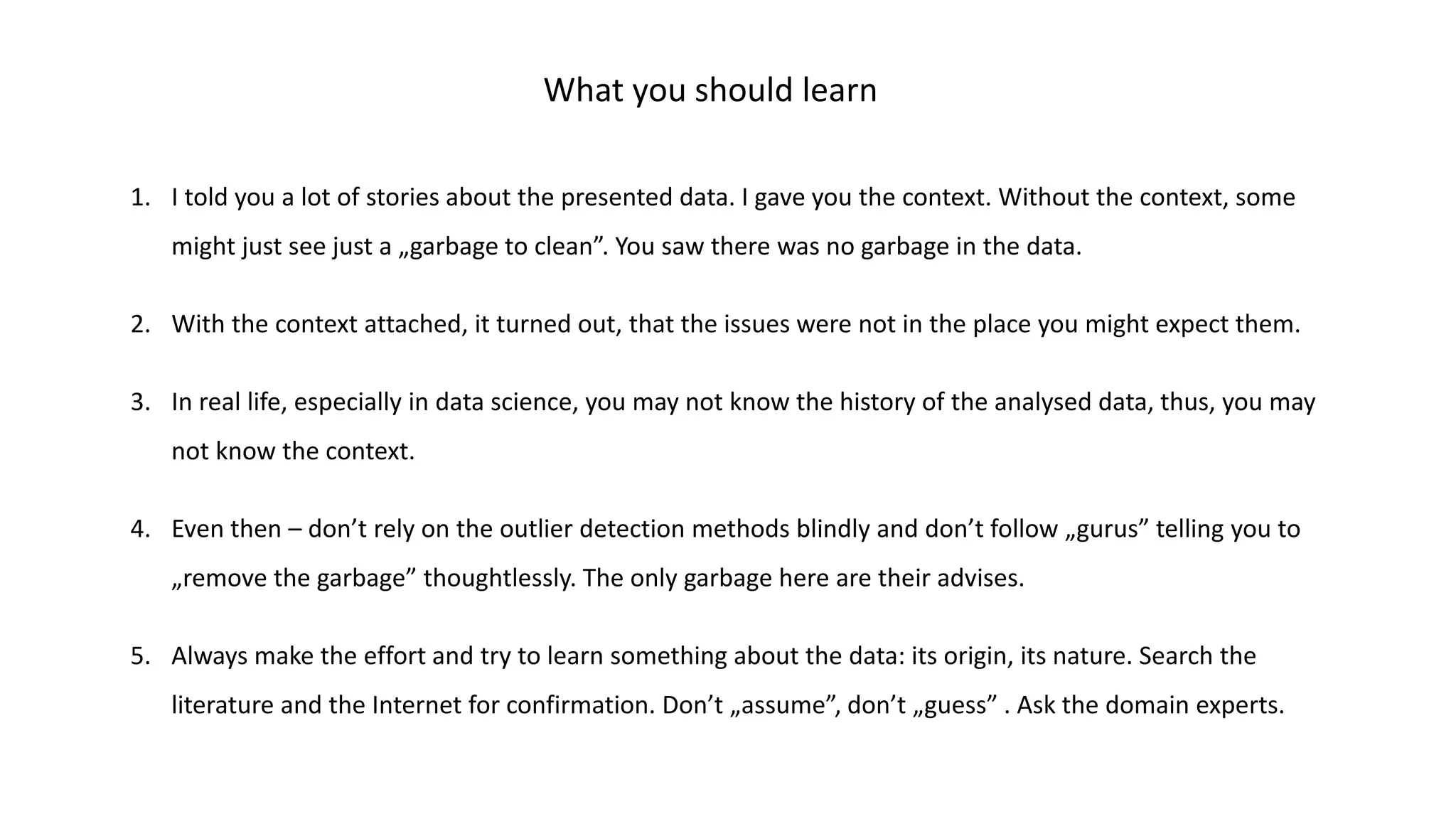The document emphasizes the importance of not disregarding outliers in data analysis, warning that outliers may indicate data collection errors or signal critical issues, as demonstrated by the Flint water crisis. It critiques common statistical methods for outlier detection that lack context and cautions against blindly removing outliers, as they can represent meaningful deviations rather than errors. The author advocates for careful examination of outliers in conjunction with clinical and contextual understanding to avoid misinterpretation of the data.
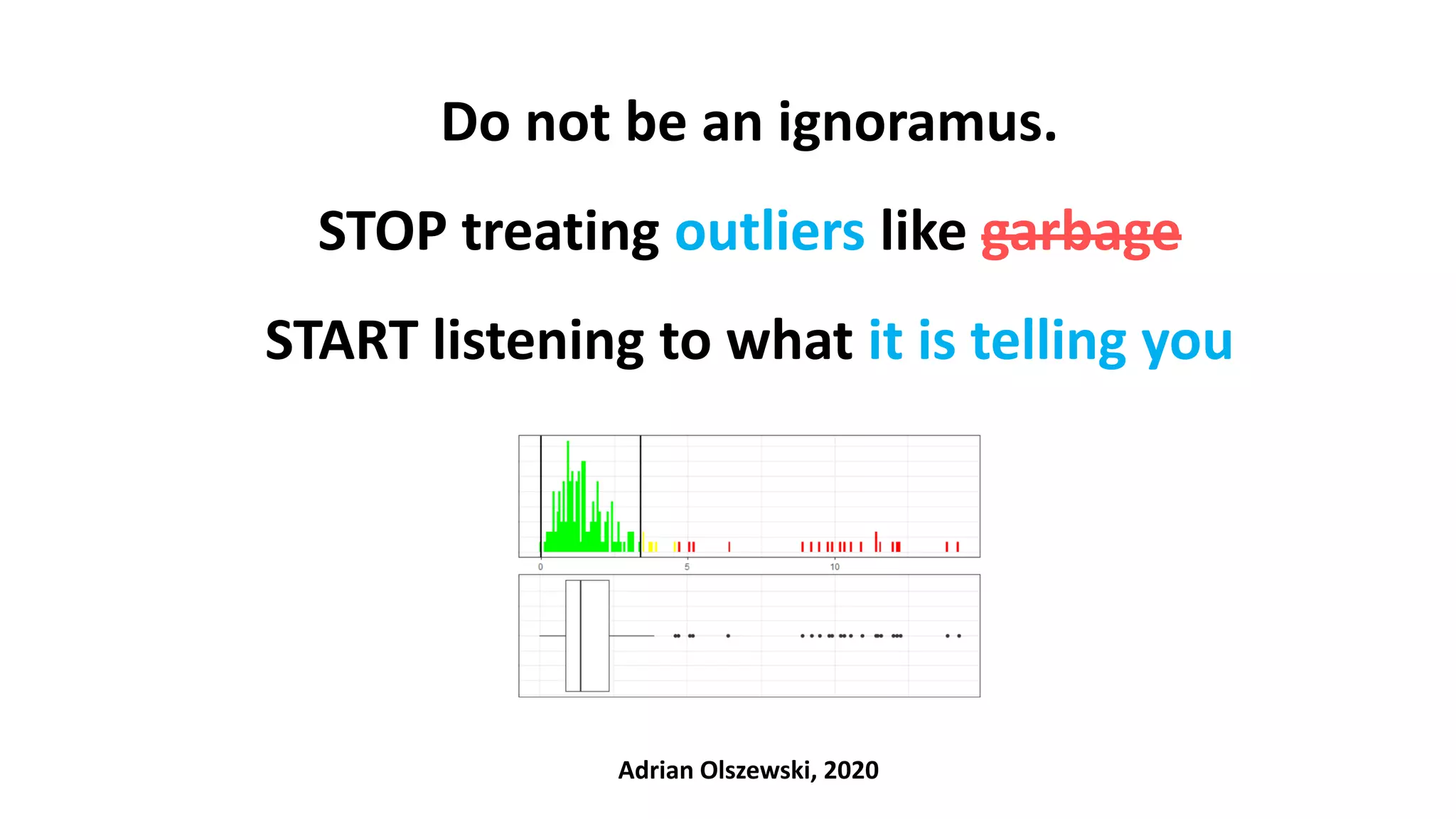



![A few words of explanation before we start…
• SDV – source data verification: verification of the data entered to a database against the source (e.g. paper) documentation
• MDV – medical data review: verification of the data (any) against the domain (here: clinical) relevance by a domain specialist (physician)
• Late (post-factum) validation – a validation done during the systematic data review or even the analysis („strange, that looks weird…”)
• Inclusion / Exclusion criteria – as set of rules determining whether a patient is eligible to enter the trial
• Reference Range [RR] – a range covering values of a certain clinical parameter deemed as normal in a population of healthy patients
• Observation out of the RR (o.o. RR) and clinically non-significant – a value of a certain clinical parameter, which exceeds the RR, but
is treated by the physician as normal (not worrying) given the circumstances.
For example, the physician knows that patient ate something sweet or greasy, drunk water, did gymnastics shortly before the blood test).
Examples: glucose 105mg/dL, AspAT 45 IU/L (or even 110 IU/L, if you ate pizza and drunk alcohol a few hours earlier)
• Severe patient – a patient with a certain clinical parameter exceeding the reference range (e.g. patients with hypercholesterolemia)
• Fake data - data, that are made up during entering it into a database („I don’t have this value… let’s be creative and put 4.23”)
• Data entry error – typos, data copy/pasted from a wrong field, decimal point shifted, too many/few digits, etc.](https://image.slidesharecdn.com/outliersaoli-201129222937/75/Dealing-with-outliers-in-Clinical-Research-5-2048.jpg)
![LDL-C HDL-C TG TC TC Friedewald |Δ| (%Δ wrt TCFr) Opinion
110.5 43 120 179 177.5 1.5 (0.8%) OK
120.3 52 130 168 198.3 30.3 (15.3%) query it, just in case
92 32 139 125 151.8 TC < LDL + HDL + TG/5 query it
It was hard to catch, as the
value is in the reference range
and looks good itself.
But, analysed in the context, it
looks suspiciously and should
be confirmed via medical query.
When you might expect, that the „data entry errors” will result in outliers, but it does not…
You might expect, that data entry errors will result in outliers. Say, one put 100.2 rather than 10.02. Or 555 when it should be 5.55.
But what, if the data entry error results in data, that looks perfectly OK?
Let’s have a look at an example of data, that looks correct, but it is not. Let’s consider a lipidogram, consisting of the following parameters:
• Total cholesterol [TC]
• Triglycerides [TG]
• Low-Density Lipoprotein cholesterol [LDL-C]
• High-Density Lipoprotein cholesterol (HDL-C]
Assume, that the patients’ condition allows us to validate the results using the Friedewald formula (results expressed in mg/dL):
TC = LDL-C + HDL-C + TG/5
Now look at the data set below. The values don’t have to match exactly, but should more or less agree](https://image.slidesharecdn.com/outliersaoli-201129222937/75/Dealing-with-outliers-in-Clinical-Research-6-2048.jpg)


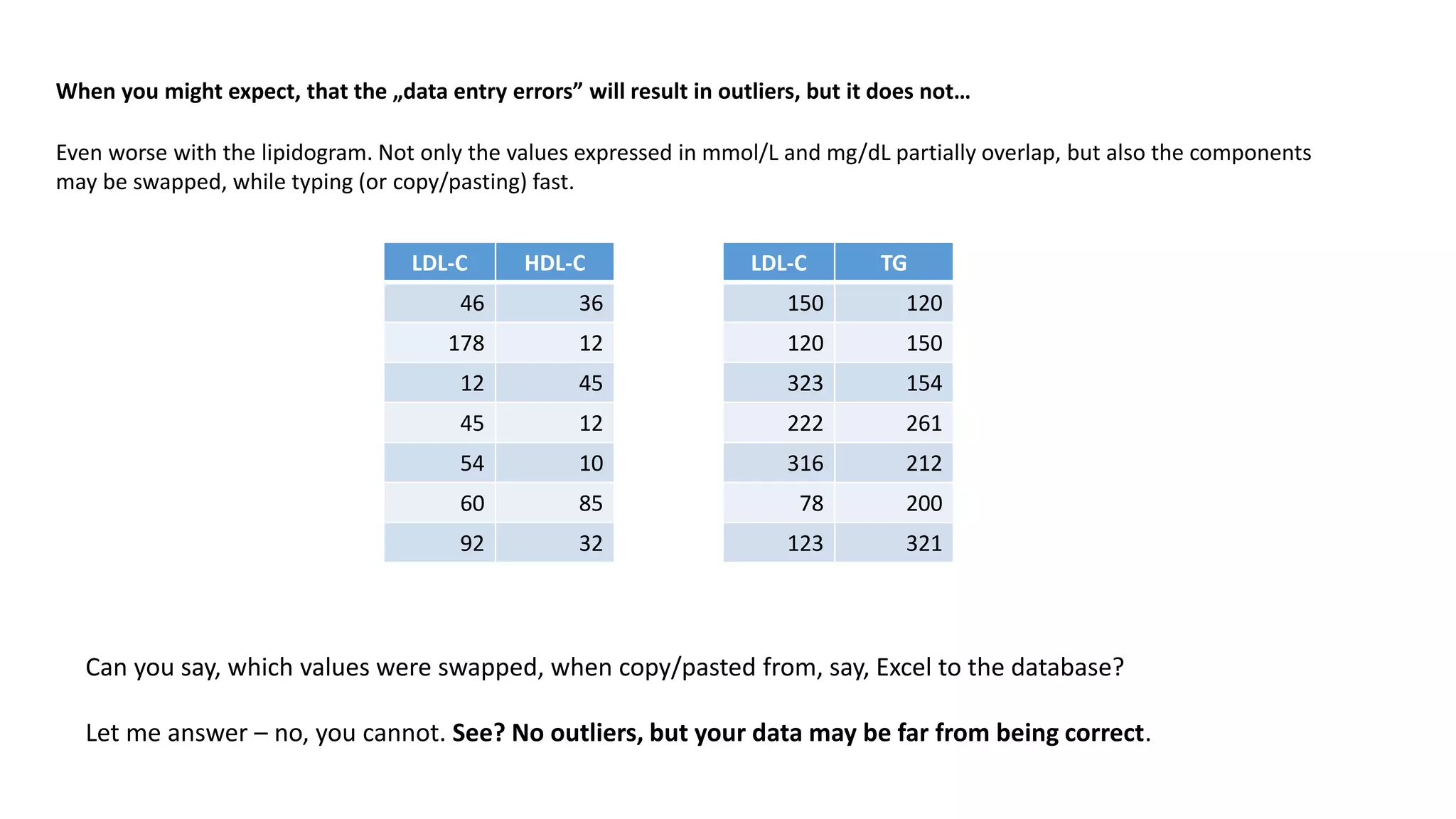



![Technically both are outliers, but clinically OK.
Status: it’s a problem due to unmet inclusion
criteria - both observations are < A
Technically both are outliers.
Clinically o.o RR, but non-significant.
Status: it’s OK
Technically an outlier.
Clinically o.o. RR and significant.
Status: It’s OK
A [inclusion criteria: X must be > A]
Technically an outlier, clinically OK
Status: it’s OK
Technically all are outliers, clinically OK
Status: it’s OK
* Green bands depict reference ranges [RR] covering the normal values in healthy patients
Let’s add some context and observe the status
Context #1 – some fake story about the data (you don’t know). Just look at the statuses to see, how the context changed the meaning of outliers. Tests won’t tell you that.
Context #2
Example #1](https://image.slidesharecdn.com/outliersaoli-201129222937/75/Dealing-with-outliers-in-Clinical-Research-13-2048.jpg)
![* Green bands depict reference ranges [RR] covering the normal values in healthy patients
Let’s add some context and observe the status
Context #1
Context #2
Example #2
Technically both are outliers.
Clinically o.o. RR and significant.
Status: it’s OK
Technically OK.
Clinically o.o. RR but non-significant.
Status: it’s OK
Technically OK.
Status: it’s a problem - typo
Technically OK
Status: it’s a problem – confused units
Technically both are outliers.
Clinically o.o. RR and significant.
Status: it’s a problem – typo
Technically all are OK.
Clinically o.o. RR and significant.
Status: it’s a problem due to met
exclusion criteria – X < A
Technically both reds are OK.
Clinically o.o. RR but non- significant.
Status: it’s a problem – confused units or made up data
[exclusion criteria: X < A] A
Technically all those yellow-greens are OK.
Clinically o.o. RR but non-important.
Status: it’s OK](https://image.slidesharecdn.com/outliersaoli-201129222937/75/Dealing-with-outliers-in-Clinical-Research-14-2048.jpg)
![* Green bands depict reference ranges [RR] covering the normal values in healthy patients
Let’s add some context and observe the status
Context #1
Context #2
Example #3
In this area all points are clinically o.o. RR and significant.
The circled two are technical outliers, reported by the tests.
Status: it’s OK – only severe patients are recruited in this trial
Technically both are outliers, but clinically OK.
Status: it’s a problem, due to unmet inclusion
criteria: only severe patients are recruited in this trial
Technically outlier, clinically o.o. RR and
important.
Status: it’s a problem - typo
Those are technically OK.
Clinically OK. A few are o.o. RR but non-significant.
Status: it’s a problem – unment inclusion criteria
A [inclusion criteria: X must be > A]
Technically OK, clinically OK
Status: it’s a problem – confused units
Technically an outlier. Clinically OK.
Status: it’s OK
Technically an outlier, but clinically OK.
Status: it’s a problem - typo
Technically outlier, clinically OK
Status: it’s a problem – made up](https://image.slidesharecdn.com/outliersaoli-201129222937/75/Dealing-with-outliers-in-Clinical-Research-15-2048.jpg)
